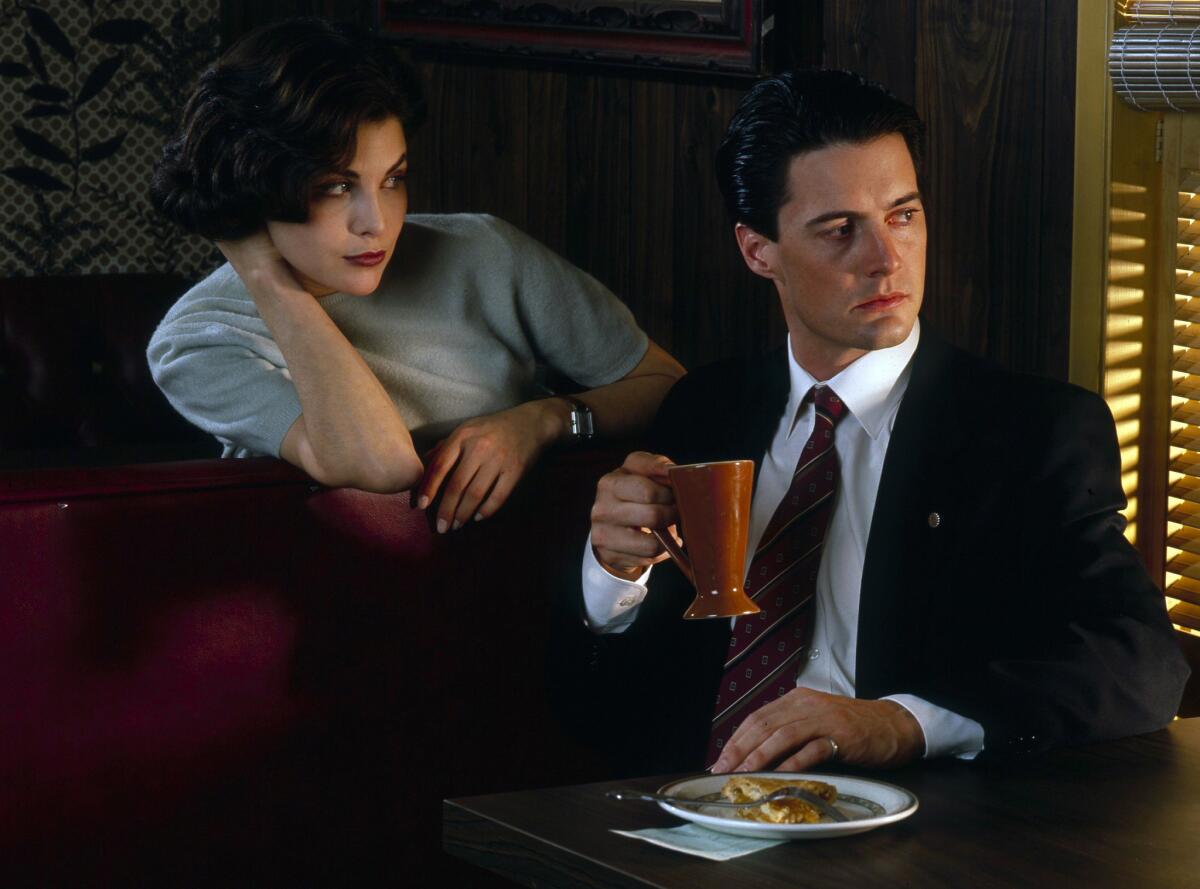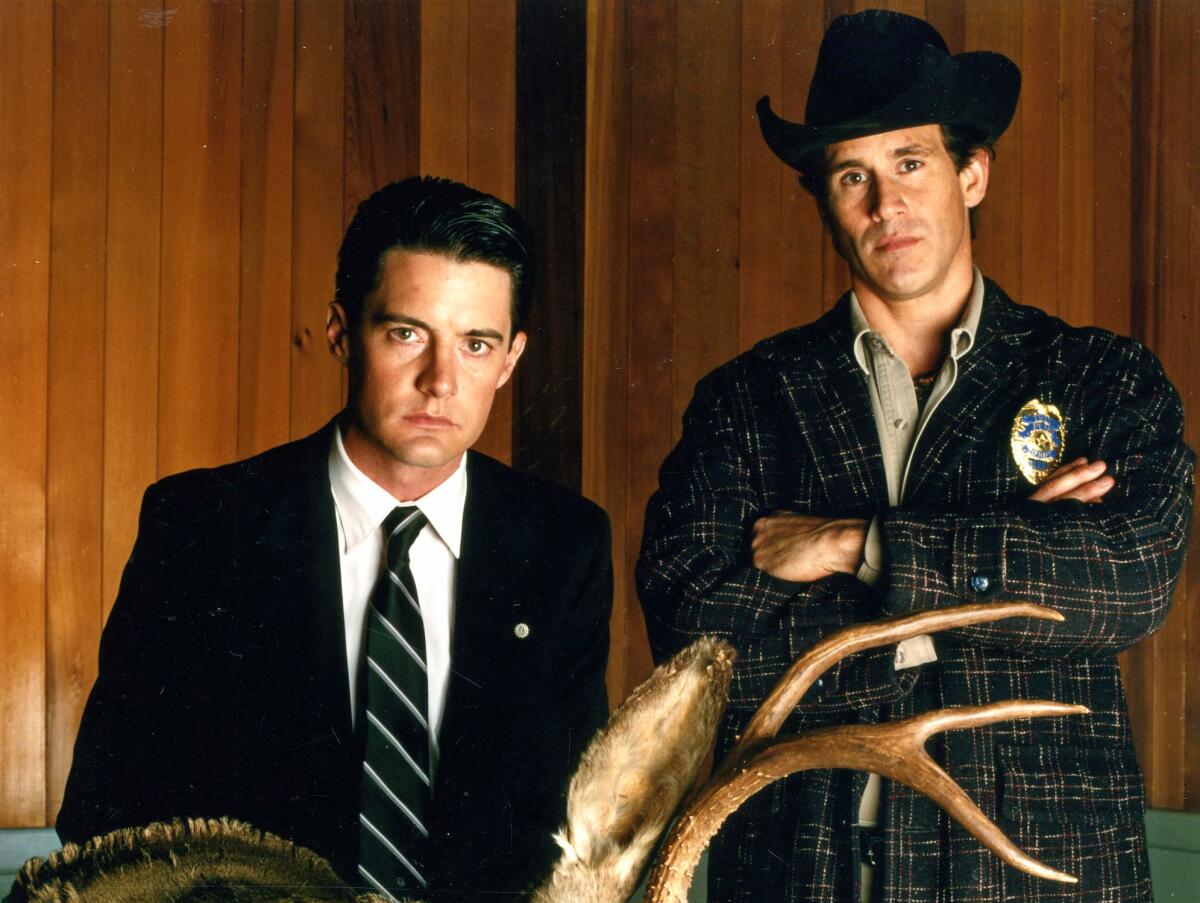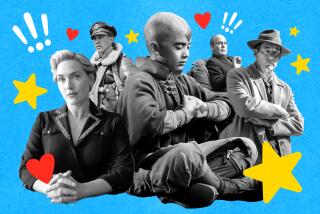Misfit TV shows are finally getting the respect they deserve

Sherilyn Fenn and Kyle Maclachlan in “Twin Peaks.”
They are network and cable shows that were largely ignored in living rooms across America when they first aired but have since gone down as some of the best and most influential television programming in recent history. We’re talking about productions such as “Twin Peaks,” “The Wire” and “Freaks and Geeks,” shows that stood out among their predictable sitcom and game-show brethren with quirky narratives, cutting-edge production, disturbing thematics and off-the-grid humor. They didn’t inspire ratings landslides, but they did lay the groundwork for what we celebrate today — more original programming. Here’s a list of our personal favorites:
See more of Entertainment’s top stories on Facebook >>
‘Freaks and Geeks’
Original air date: 1999
Number of episodes: 18, though four didn’t air
Network: NBC
Emmy nominations: Three, including two for Paul Feig’s writing, and one win (quite justifiably, for casting)
Tagline/logline: What high school was like for the rest of us.
What was it about? Created by Feig and developed with executive producer Judd Apatow, “Freaks and Geeks” took an honest look at the perils and occasional small victories of adolescence. Was it too honest for an audience accustomed to wading through the melodrama of “Dawson’s Creek”? Maybe. But the show’s initial Saturday night time slot didn’t help. Nor did being bounced off the air for post-season baseball. How can an audience show up if viewers can’t find you?
What initially turned America off? Again: Nothing. NBC bounced “Freaks” all over the prime-time map. What’d you want it to do? Mix in shirtless jocks and perky cheerleaders. You do get the show’s title, right?
Why it might succeed today: Thanks to home video and especially Netflix, this perfectly written, acutely observed coming-of-age series actually is thriving today. Ask any high-schooler. He or she’s probably either seen it or has it in his or her viewing queue. It’s timeless.
Best shareable lines: Fatherly advice from Mr. Weir: “You know who used to cut class? Jimi Hendrix. Know what happened to him? He died. Choking on his own vomit.” Neil on dating out of your league: “The dance is tomorrow. She’s a cheerleader. You’ve seen ‘Star Wars’ 27 times. Do the math.”
Revival chances: Zero. “I’ve never seen a good reunion — in real life or on film,” Feig told The Times when asked about a possible revival. “There’s always something that’s wrong. Half the time, you’re just thinking, ‘Oh, look how old they are.’”
*
‘The Wire’
Original air date: 2002
Number of episodes: 60
Network: HBO
Emmy nominations: Two
Tagline/logline: Everything is connected
What was it about? This crime drama created by former police reporter David Simon was set in and around a mostly grim, broken and corrupt Baltimore. Each of the show’s five seasons introduced a new fresh hell — from drug dealing in the ‘hood to human trafficking on the docks to stomach-turning greed in local politics.
What initially turned America off? Because of its setting in the slums and a large African American cast, “The Wire” was mistakenly perceived as a bleak ethnic drama, which probably turned off potential viewers. The language was raw, the violence explosive and brutal. The characters were often flawed, particularly politicians, police and others who were supposed to uphold the law. Above all, “The Wire” was relentlessly dark and bleak. Victories and happy endings were few, and even characters seeking redemption were destroyed or killed. Also, the show was heavily serialized, so if you missed one episode you were lost.
Why it might succeed today: The multi-layered episodes and dark atmosphere have become staples in the elite TV drama arena. Although impossible to predict, the show launched the careers of key cast members, particularly Idris Elba, Dominic West, Michael B. Jordan and Michael K. Williams. Several others, including Wendell Pierce, Lance Reddick and Clarke Peters, have become familiar faces on the big and small screens.
Best shareable lines: “You follow drugs, you find drug addicts and drug dealers” — Det. Lester Freamon. “Omar comin’!” — scattering pedestrians every time gun-toting thug Omar Little walked down the street. “All in the game, yo. All in the game” — Omar Little.
Revival chances: Slim to none. Simon has moved on to other territory — he was the force behind HBO’s recent “Show Me a Hero” and a series about post-Katrina New Orleans, “Treme.”
*

Kyle MacLaughlin, left, and Michael Ontkean in “Twin Peaks.”
‘Twin Peaks’
Original air date: 1990
Number of episodes: 30
Network: ABC
Emmy nominations: 18, two wins (editing and costume design; who cares!)
Tagline/logline: Who killed Laura Palmer?
What was it about? This series was part psychological thriller, part surreal murder drama, part supernatural campy horror flick. Oh, and did we mention that it defied genre classification? The twisted brainchild of Mark Frost and David Lynch, “Twin Peaks” set the bar for non sequitur weirdness in a network TV series. Bonus points: It starred the “Mod Squad’s” Peggy Lipton.
What turned America off? “Twin Peaks” initially was a bona fide national phenomenon — and then the infamous dancing red dwarf appeared in one of Agent Cooper’s dreams and audiences en masse rose out of their La-Z- Boy recliners and changed the channel. Just think how the “Red Wedding” episode of “Game of Thrones” would have gone over then. All the talk of White and Black Lodges didn’t help. But the dark tale of a father sexually abusing, then killing his daughter was too much for an America that loved “Knight Rider.”
Why it might succeed today: Thanks in part to “Twin Peaks” and its influence on American television, audiences now insist on quirkiness and are perfectly fine with aesthetically rendered incest and serial murder.
Best shareable lines: Evil Windom Earle asks a captive Maj. Garland Briggs what his greatest fear is. Briggs replies: “The possibility that love is not enough.” And of course the Log Lady: “My log doesn’t judge.”
Revival chances: Excellent, though still not out of the Black Lodge yet. Showtime has Lynch on board, but the return of the series has now been pushed back to 2017.
— Martin Miller
*
‘Battle of the Network Stars’
Original air date: 1976
Number of episodes: 19
Network: ABC
Emmy nominations: Zero, and yes, it was robbed
Tagline: Television’s hottest stars, going for all the action and glory!
What was it about? Perhaps this grab bag of ‘70s and ‘80s TV personalities, including Telly Savalas, Jimmie Walker and Lynda Carter, was just too ambitious for audiences used to seeing their favorite stars in a more conventional game show and/or wacky sitcom setting. Here, they competed in a motley assortment of demanding athletic contests, such as obstacle courses, kayaking and ogling the bouncing chest of “Maude” costar Adrienne Barbeau. Loosely modeled on “The Superstars,” an ABC show that featured actual athletes, this series of specials ran occasionally for years and helped usher in the reality TV era.
What turned America off? It lacked athletic prowess of “Baywatch.” Savalas gave interviews to host Howard Cosell between puffs on a cigarette.
Why might it succeed today: Its “celebreality” factor. It was perhaps the first to put real-life stars in ridiculously contrived competitions.
Best shareable lines: “That’s a penalty for sure!” Cosell cried when Barbeau lost her grip on the monkey bars in her race against “Little House on the Prairie” star Karen Grassle and instead of climbing back on just ran to the next obstacle.
Revival chances: Given that the three-network world no longer exists, it would be hard to recapture the magic, although there’s always hope. In the meantime, repeats of the original have turned up on ESPN Classic.
*
‘Noah’s Arc’
Original air date: 2005
Number of episodes: 17
Network: Logo
Emmy nominations: None
Tagline/logline: Love to the beat of a different drum.
What was it about? The series by Patrik-Ian Polk focused on four black gay friends living in Los Angeles as they navigated the complexities of love and career. It was often referred to as the black, gay version of “Sex and the City.”
What initially turned America off? No one quite knows why “Noah’s Arc” was canceled after just two seasons, including the lead actors and director. In addition to the show being the network’s highest-rated original series at the time, when its plot lines were wrapped in a feature length film, “Noah’s Arc: Jumping the Broom,” averaged more than $30,000 on five screens in its limited-release debut. But “Noah’s Arc” did tackle a number of issues considered taboo at the time — and some even today: same-sex parenting, “down low” culture, HIV and AIDS, promiscuity, gay bashing, homophobia in the black community and more.
Why it might succeed today? Before “Empire,” “How to Get Away With Murder,” “black-ish” and even “Glee,” “Noah’s Arc” was pushing the envelope as an unapologetic depiction of black, gay and black and gay life. Considering the push for diversity and Twitter’s role in TV, it would be difficult for a network to let such a show leave its schedule. And for the record, another show like it still has yet to be made.
Best shareable lines: “Life is not a soap opera” Ricky said in response to Brandon’s hopeful aspirations about Noah and Wade’s romantic relationship.
Revival chances: Unlikely. It’s been 10 years.
*
‘Studio 60 on the Sunset Strip’
Original air date: 2006
Number of episodes: 22
Network: NBC
Emmy nominations: Five, including casting and directing for a drama series; one win, for guest actor John Goodman
Tagline/logline: The stars are about to collide.
What was it about? A show within a show, this comedy-drama took a behind-the-scenes look at how a sketch comedy a la “Saturday Night Live” was made. In real life, this quirky production was Aaron Sorkin’s next project after the much-revered “West Wing.” Starring Matthew Perry and Amanda Peet, “Studio 60” offered a razor-sharp view of the world around us through the medium of television.
What initially turned America off? In wake of Sorkin’s previous hit series, the expectations for “Studio 60” were high. But while “The West Wing” tugged at the notion of blind patriotism, the “SNL”-lite backdrop of “Studio 60” was criticized for being self-absorbed and preachy even before Sorkin’s later project “The Newsroom” took it to new levels. Others scoffed at the believability of the fake show — lamenting that its sketches weren’t even funny.
Why it might succeed today: The first season averaged about 7 million viewers — definitely not impressive by 2006 standards. But in the age of fragmented audiences and streaming services, it’s not terrible. And, hey, “Saturday Night Live” still has folks talking about its commentary on pop culture and politics. We’d even vote for a shift in focus to the creative process of a “Daily Show”- or “Last Week Tonight”-esque program that took us into the world of the young writers who were igniting national discourse, influencing American politics and generating headlines.
Best shareable lines: Matt Albie (Perry) delivering a sentiment we can all relate to when dealing with office shenanigans: “I’m the only sane person I know.”
Revival chances: With Sorkin at the wheel, doubtful. After the conclusion of “The Newsroom” in 2014, he told The Times that he was likely done writing television.
*
‘Sports Night’
Original air date: 1998
Number of episodes: 45
Network: ABC
Emmy nominations: Eight, three wins
Tagline/logline: It’s about sports. The same way that “Charlie’s Angels” was about law enforcement.
What was it about? Sorkin’s first TV show--he long predated the influx of film creators to television--looked at the inner workings and relationships of a “SportsCenter”-like broadcast. Sorkin brought his trademark quicksilver dialogue and an extremely solid ensemble — Felicity Huffman, Robert Guillaume, future dramatic stars Peter Krause and Josh Charles — to the medium, along with an ambitious mix of tones. The show was known for its combination of fizzy banter and serious themes--the medical hiatus of Guillaume’s Isaac Jaffe character, or Joshua Malina’s impassioned animal-rights speech--offering a surprisingly complete package in 22-minute increments.
What initially turned America off? Coming in an era of “Friends,” “Will & Grace” and other shows with brightly flashing “comedy” arrows on the one hand — and rigorous hourlongs like “ER” and “NYPD Blue” on the other — “Sports Night” defied categorization. It was too funny for those who wanted a drama (remember the faint laugh track in the first season?) and too weighty for those who wanted to chuckle. The idea that a show could be both was novel--too novel, and even intelligent viewers were sometimes confused.
Why it might succeed today: From “Modern Family” to “The Office” to “Transparent,” TV in the last decade has been filled with smart half-hour shows that find comedy in characters, clever dialogue and everyday moments — all “Sports Night” specialties. The present era also sees much more energy aimed at, and tolerance given to, shows that walk the line between comedy and drama, a tonal balance that “Sports Night” was among the first to strike.
Best shareable lines: “I gotta tell you, at this point, the length of this conversation is way out of proportion to my interest in it,” Charles’ Dan Rydell offered with characteristic zinginess. Or “Exaudio, comperio, conloquor. That’s a Latin phrase that translates: to listen, to learn, to speak.” It’s also the beginning of a classic Sorkin monologue, in this case delivered by Jaffe about an athlete at a Southern college protesting the Confederate flag. Many of the best lines were delivered on the move — Sorkin’s “walks and talks” had arrived.
Revival chances: Nonexistent, though fans of Sorkin did get to see him return to the behind-the-TV-curtain conceit again, with the short-lived “Studio 60 on the Sunset Strip” and the longer-lived “The Newsroom.”
*
‘Deadwood’
Original air date: 2004
Number of episodes: 36
Network: HBO
Emmy nominations: 28, with eight wins, including directing, cinematography and art direction
Tagline/logline: A hell of a place to make your fortune.
What was it about? This dark take on the American western was the brainchild of David Milch, co-creator of “NYPD Blue.” Gorgeously crafted, it mixed fiction with historical truths in telling the story of a town’s struggle to come to terms with the end of the Wild West. Set in the Black Hills of South Dakota, the series boasted an expansive cast, starring Timothy Olyphant and Ian McShane and had 43 uses of the “F word” in its first episode. It’s now seen as part of the trifecta (along with “The Sopranos” and “The Wire”) that solidified HBO as a home for the dark, critically acclaimed cable drama.
What initially turned America off? Almost certainly the profanity. The choice for characters in late 1800s Dakota Territory to swear freely and modernly was made by Milch to avoid having the mood of the series spoiled by period-accurate verbiage, which would be internalized as much more mild to modern audiences. Milch also wrote “Deadwood” in a flowery yet precise style akin to Shakespeare but with swears. There’s also the matter of nudity. Having many of the main locations for the series be whorehouses meant the amount of breasts shown gave “Game of Thrones” a run for its money.
Why it might succeed today: “Game of Thrones” has really upped the ante on what audiences will sit through as far as nudity and violence go, and hope springs eternal, given the increasing number of alternative television delivery methods, that the show would be more effective at finding and cultivating its cult audience and extending its run some.
Best shareable lines: Difficult, considering the amount of profanity used, but maybe the gold standard of “Deadwood” philosophy as delivered by Al Swearengen: “Pain or damage don’t end the world. Or despair or … beatings. The world ends when you’re dead. Until then, you got more punishment in store. Stand it like a man… and give some back.” But sometimes Al doesn’t mince words, as in his nonchalant dismissal of a flunky: “Don’t forget to kill Tim.”
Revival chances: Better than you’d think. When HBO canceled the series in 2006, it stated that there would be two “Deadwood” movies forthcoming, though nothing ever came of them. But as recently as August of this year, reports were burbling yet again of a “Deadwood” movie. Fingers crossed that we’ll hear more than rumors in the new year.
More to Read
The complete guide to home viewing
Get Screen Gab for everything about the TV shows and streaming movies everyone’s talking about.
You may occasionally receive promotional content from the Los Angeles Times.






